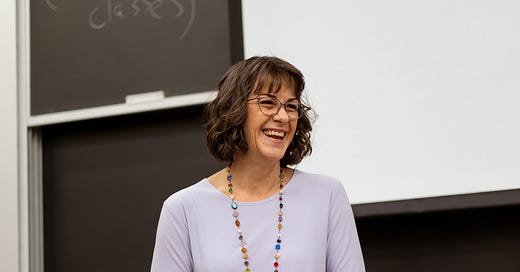What I learned speaking to a UC Davis communications class
People want the information. They just need to learn how to decipher what’s trustworthy and accurate.
What does it mean to be a journalist these days? I tried to answer that question on May 20 when I spoke to a mediated communication class at UC Davis.
Three days earlier, I announced in The Davis Enterprise that I was leaving the paper I had loved for 25 years, after the messy layoff of longtime columnist Bob Dunning. Communications Professor Narine Yegiyan contacted me, saying the timing was perfect for her Monday class, where she planned to discuss the state of local news.
It was mostly a Q&A, thank goodness, because I didn’t have much time to prepare.
I tried to convey the value of local news to a lecture hall full of students who, their teacher says, are in constant scroll mode. They admit they get their news from social media. It’s no wonder they have a growing cynicism of news outlets, and think most news sources are biased.
I spoke about the economic struggles of the local newspaper and why I chose to leave it for Substack, a subscription-based writer’s platform where I could communicate directly with my audience, without relying on ads.
Here I am speaking to Narine Yegiyan’s mediated communication class at UC Davis on May 20. (Photo by Patrick Collins)
I won’t repeat every question here, but my favorite one came from a young lady who asked, “Why not use social media instead? You have the credibility. Why not monetize your page and get a wider audience.
“We use social media as a baseline to get information,” she continued. “Wouldn’t it be better to have it there, where people can see it?”
Well, people are seeing it. As I write this 12 days after joining Substack, I have more than 3,000 subscribers, nearly a third of them paid. Though that’s half of my Comings & Goings Facebook following, it’s growing at a rapid pace.
I told her I do use Facebook and Instagram, but see them as tools to share what I write elsewhere. I don’t expect everyone to be on social media. Many of us have reservations with the amount of data Meta and other companies collect, and the personalized ads they feed you.
Also, social media is a huge time-sucker. Most times I go on Facebook to look for one thing, I’m stuck there for an hour or more, watching tips on picking the right wedding dress (It knows my son is getting married next year), or hearing about the new Trader Joe’s finds that fit my apparent addiction to low-calorie, high-protein foods.
I love Substack’s clean, ad-free format, delivered straight to my subscribers’ email in-boxes. After all, people don’t subscribe to newspapers for the ads. They want quality journalism.
I get paid more than I would on Facebook, and a lot more than I did with The Enterprise. Previously, my biggest gauge of my column’s value was my kudos file, where I kept all the thank-you emails from readers. In a week and a half, those are the readers whose support allowed me to buy a new laptop to replace a 10-year-old one The Davis Computer Doctor said wouldn’t last the year.
One student asked if I get writer’s block. Well, I might struggle over trying to come up with a catchy lede or headline, but when there is news, the words don’t get in the way. Writing on deadline – and deadlines don’t budge – is not creative writing. It’s about getting the information out as clearly and succinctly as possible. Usually, the more I proofread, the shorter the story becomes.
Don’t overthink it, I told them. Avoid jargon and acronyms. Write as if you’re explaining your story to a fifth grader. Don’t assume people know about your topic. It never hurts to explain.
Do I see my kind of journalism coming back? Well, I see how much people crave news. They just don’t trust where to get it. Look at the popularity of Nextdoor, a social networking service for neighborhoods. It’s a place where rumors run rampant. I see many questions about business changes – ones that would easily be answered if they read my column. (Pass the word, would ya?)
Hopefully, the pendulum will swing to back to the side of truth. People want the information. They just need to learn how to decipher what’s trustworthy and accurate.
Yegiyan said my work was an example of local news done right. “You are in a very unique position, a journalist who is very local, who still values these original traditions as a commitment to the people. You know your audience. They know you. You are connected with them beyond the newspaper. That is your power.”
I appreciate that. I hope her students will too.
– Comings & Goings is also on Facebook and Instagram. If you know of a business coming or going in the area, email news tips to wendy@comingsandgoings.news.






Excellent column, Wendy. Bravo for speaking to the students & for helping all readers understand the profound changes in where folks look for news & how writers committed to facts & truth can reach them.
Good column! Comings & Goings generally, today's column in particular, and your conversation with the students in Prof. Yegiyan's class are examples of the types of work and engagement that can help people rediscover the value of local news. Thanks also to Prof. Yegiyan for bringing you into the discussion with her students.